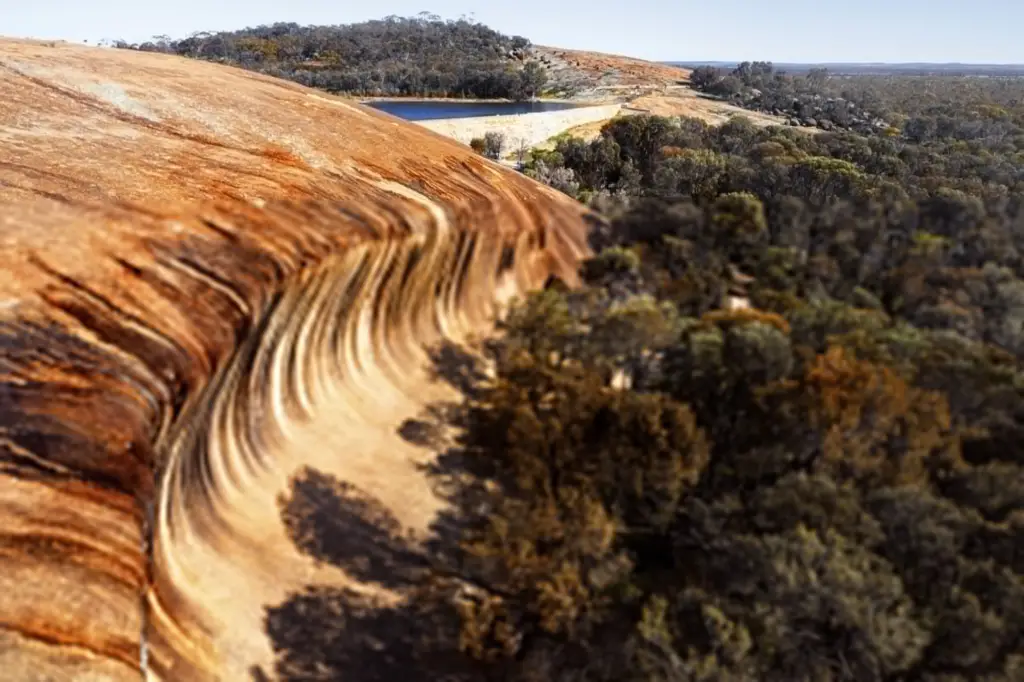Deep in the heart of Western Australia, near the town of Hyden, stands one of nature’s most extraordinary creations: Wave Rock. This iconic granite formation, resembling a massive wave frozen in time, is a testament to the power of geological forces and erosion over billions of years. With its striking appearance and cultural significance, Wave Rock is both a scientific wonder and a cherished landmark.

What is Wave Rock?
A Natural Masterpiece
Wave Rock is a granite rock formation that rises approximately 15 meters (49 feet) high and stretches over 110 meters (360 feet) in length. Its unique curved shape mimics the crest of an ocean wave poised to crash, creating a surreal and awe-inspiring sight in the midst of Australia’s outback.
How Was Wave Rock Formed?
The Geological Process
Wave Rock’s formation is the result of over 2.7 billion years of geological evolution. The process involves:
- Weathering: The granite surface was gradually exposed due to the erosion of softer surrounding rock over millions of years.
- Rainwater Erosion: Water running down the rock face caused chemical weathering, carving out the concave wave-like shape.
- Color Bands: The distinctive stripes on Wave Rock are formed by deposits of minerals such as iron oxide and algae, which stained the surface over time.

A Monument of Ancient Earth
Wave Rock is part of a larger granite outcrop known as Hyden Rock, which serves as a window into the Earth’s ancient past. The rock’s age, estimated at 2.7 billion years, makes it one of the oldest known geological formations on the planet.

Cultural Significance
Aboriginal Heritage
Wave Rock holds deep cultural importance to the local Noongar people, the Aboriginal custodians of the land.
- Dreamtime Stories: The formation is connected to Aboriginal mythology, symbolizing a giant serpent known as the Rainbow Serpent, a creator figure in Dreamtime lore.
- Sacred Site: For the Noongar people, Wave Rock and the surrounding area are sacred, reflecting their spiritual connection to the land and its natural features.
Tourism at Wave Rock
A Must-Visit Destination
Wave Rock attracts thousands of visitors each year who come to marvel at its unique beauty and learn about its history.
- Photo Opportunities: The rock’s striking shape and vibrant colors make it a favorite spot for photographers and travelers alike.
- Nearby Attractions: Visitors can also explore other notable sites near Wave Rock, such as:
- Hippo’s Yawn: A rock formation resembling a yawning hippopotamus.
- The Humps: Another granite outcrop featuring ancient Aboriginal rock art.
- Mulka’s Cave: A site rich in Aboriginal legends and hand-stencil art.
Amenities and Accessibility
Wave Rock is easily accessible via well-maintained roads from Hyden, with facilities such as parking, picnic areas, and walking trails available for tourists. The Wave Rock Caravan Park provides accommodation for those wishing to extend their stay.

Conservation and Sustainability
Protecting a Natural Wonder
Efforts are underway to ensure Wave Rock’s preservation, including:
- Erosion Control: Measures to prevent further erosion caused by human activity.
- Cultural Respect: Educational programs to promote awareness of the site’s Aboriginal significance.
- Tourist Guidelines: Encouraging responsible tourism to minimize environmental impact.
Scientific Significance
Wave Rock isn’t just a tourist attraction; it is also a site of geological importance. It offers scientists a unique opportunity to study:
Like Us on Facebook!
- Granite Weathering: The processes behind the formation of curved rock structures.
- Ancient Earth: Insights into the Earth’s early geological history and the evolution of its crust.
Visiting Wave Rock
Best Time to Visit
The best time to experience Wave Rock is during the cooler months of April to October, when the weather is mild. Early morning or late afternoon visits are recommended for stunning lighting conditions that enhance the rock’s colors and contours.
Subscribe Us on YouTube!
How to Get There
Wave Rock is located approximately 340 kilometers (211 miles) east of Perth, making it a perfect day trip or weekend getaway. Visitors can drive or join guided tours that offer insights into the site’s geology and cultural heritage.
Conclusion
Wave Rock is more than just a striking geological formation; it is a symbol of natural wonder and cultural heritage. With its breathtaking beauty, ancient origins, and profound significance to the Noongar people, Wave Rock stands as a reminder of the Earth’s enduring power and the deep connection between humans and the land.
Whether you’re a geologist, a history enthusiast, or a traveler seeking inspiration, Wave Rock is a destination that promises awe, discovery, and a sense of timeless wonder.

















